ISSN ONLINE(2319-8753)PRINT(2347-6710)
ISSN ONLINE(2319-8753)PRINT(2347-6710)
Mustapha Abdulhadi1, Sadi Ibrahim Haruna2 Samir Bashir3
|
| Related article at Pubmed, Scholar Google |
Visit for more related articles at International Journal of Innovative Research in Science, Engineering and Technology
This paper simulates the concrete under the action of hydraulic fracturing in â -â ¡ mixed mode fracture. Double-K fracture criterion results in two different loading modes, that is, crack initiation and instability. According to Prefabricated crack and width of the specimen, experimental study of hydraulic fracturing, and the two different loading modes fracture of the specimen were fitted by making the angle formed by the four batches of 24 specimens to be 0°, 30°, 45° and 60° respectively. Axial tensile specimens is applied using hydraulic pressure loading, the crack tip paste the half-bridge strain gages and mounted clip-on extensometer for measurement of crack initiation, extension length and crack opening displacement, the specimen on the two side of water pressure sensor for measuring the extension of the fracture pressure. The total fracture toughness is calculated using overlay method from double-K fracture parameters that is water pressure and axial loads. Study found that, â -â ¡ mixed mode fracture study used two different loading modes component, that is type â and â ¡ fracture component. Under the same angle, and are basically the same, and all specimens with prefabricated crack, the crack width decreases with an increase in angle.
Keywords |
| Include at least 4 keywords or phrases |
I. INTRODUCTION |
| Hydraulic fracturing from the oil and gas industry, with over half a century of development, has been in a wide range of applications such as geotechnical engineering, hydraulic structures etc. Research on hydraulic fracturing is of great important not only for the production and living, but also in possible accident prediction and prevention. Foreign scholars have done a few relevant studies. Bthuwiler and Saouma [1-2] studied the role of hydraulic fracturing under the pressure in the expansion cracks in the distribution of different sizes in different pressure expansion cracks under pressure distribution; Saouma V [3-5] and others studied the experimental research on the concrete mechanism of hydraulic fracturing, they used the concrete wedge splitting specimens, three different specimens were graded, pilot testing of hydraulic fracturing pressure of the water within the fractures distribution compared with the numerical simulation; Ito T and Hayashi K [6] carried out rock tri-axial tests on the hydraulic fracturing, which has been in the process of expansion cracks pore water pressure and the crack tip of the three-way relationship between stresses . As hydraulic fracturing research continues to develop, research by china scholars in this area is gradually increasing. Yang You Kui[7] and so on studied a constant flow of water in case the pressure distribution within the fractures were studied, water pressure calculation formula was obtained; Qin Fei, etc. [8] used the finite element method to simulate the crack under the pressure of the water as well as the expansion of the water pressure measurements; Li QingBin and Lin Gao, etc. [9] using special solution boundary element method crack water pressure triangular distribution gravity dam crack stress intensity factor; Zeng KaiHua [10] application of numerical simulation method validation considering the expressions of the principal stress fracturing pressure, hydraulic fracturing verified the destruction of progressive fracturing mechanism; in recent years, Jia Jinsheng, etc. [11] on the assumption that, crack water pressure is uniformly distributed, using the finite element method studies on the ultra-high water pressure crack propagation gravity effects; Wang JianMin, Xu ShiLang [12-14] using wedge-type compact tension specimens in the form of a hydraulic fracture test of concrete under study, using the double K fracture model of its unstable fracture toughness, toughness and cohesive crack initiation toughness, fracture toughness from its measured and calculated values were compared. |
II. EXPERIMENTAL METHADOLOGY |
| This paper focuses on the study of â  -â ¡ mixed mode fracture, according to the pre-slit width of the specimen, two kinds of fracture forms were simulated by making the angle formed by four batches of 24 specimens to be 0 °, 30 °, 45 ° and 60 ° respectively, as shown in Fig. 1-4, and the dimension as shown in Table 1. The experiment was carried out using ordinary disposable C30 concrete, and the ratio of cement, sand, gravel and water were 1: 1.32: 3.06: 0.5 respectively. Huludao Bohai Cement Co., Ltd. used the PSA32.5 of slag cement, coarse aggregate which maximum particle size does not exceed 25mm of gravel, fine aggregate particle less than 5mm of natural medium sand and water. |
 |
| The active forces of the test include axial force and water pressure. Axial force applied by hydraulic jack; water pressure provided by an electric hydraulic pump as shown in Figure 5. In order to achieve the pressure applied and sealed state, the screw and the cover of the extrusion pressure were embedded around the crack 8 screw, to achieve a sealed, water and exhaust ports were at the top of the cover. Test crack tip by attaching the half-bridge strain gauge as shown in Fig. 6, the tip of the strain measured changes in joints. In order to cover the multilayer mat rubber gasket, gaskets butter plus a painted cement mixture were used. Trials were in the pre-sewn seam at the tip and clip-on extensometer was used to measure the crack tip opening displacement and transforms the situation. Both ends of the specimen through the water pressure sensor measured water pressure and crack propagation. A pressure sensor shown in Fig. 7 and a hydraulic jack are used to connect the specimen and measure the axial load values. |
| Loading test was in two ways: |
| (1) Water pressure was applied to the case at a constant axial force; |
| (2) A constant axial force was applied under pressure. |
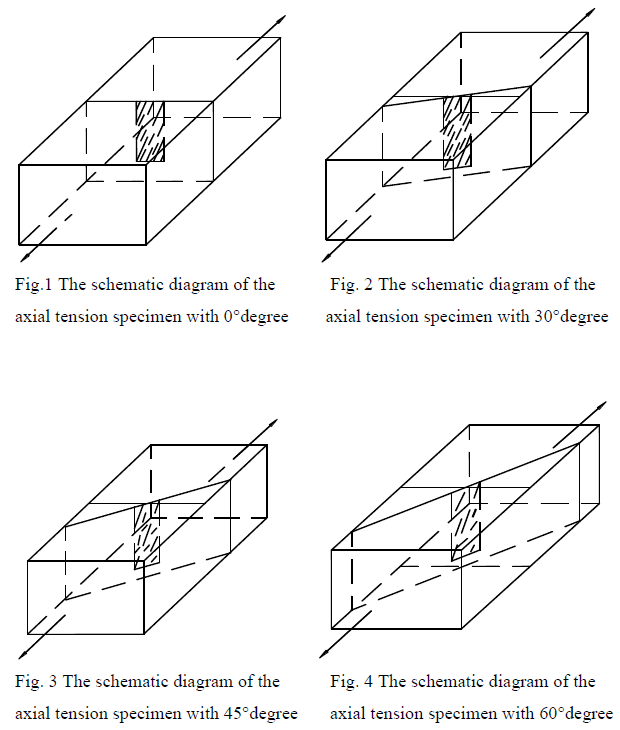 |
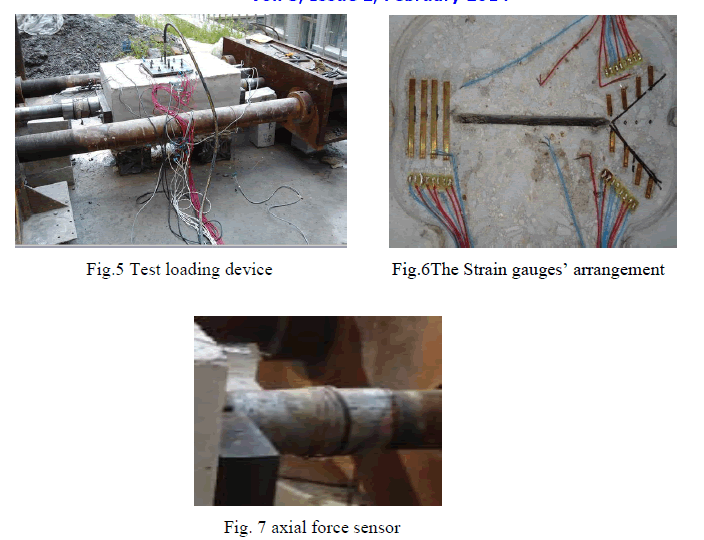 |
| Double-K fracture theory as the whole process can be divided into crack initiation, crack propagation and crack instability. Application of the theory of double-K fracture is the key to the whole process of fracture to determine the crack point and instability point. A lot of trials found that the fracture process of crack initiation point is the P-CMOD curve rises linear to nonlinear phase transition point; instability point is the point of peak load in the curve. |
| A. Experimental determination of crack initiation toughness |
| Determining the fracture toughness of the crack initiation is the key to determine the load from the main methods for crack test, that is, curve inflection point method, half-bridge and full-bridge assay method. Many experimental studies have shown that, in determining the crack initiation point, it is often not easy to determine linear and nonlinear turning point, the choice is often caused by a large human error, so this test was used to determine the half-bridge assay, initiation point through the crack tip strain gauges. From the beginning, precast concrete crack tip began to gathered energy, so the test load-strain curve had increased to extremes upward trend and started retraction, which resulted in the appearance of cracks, the aggregation energy began to be released, measuring point was unloaded, the strain began to restored the previous value of the load when the load was at the point of the crack initiation, so in this case the crack tip strain gauge full bridge of the crack fracture load is the whole process of load initiation [15] - [16]. Crack load from the load based on cutting-edge signifies that - a strain curve is determined, Fig. 4. |
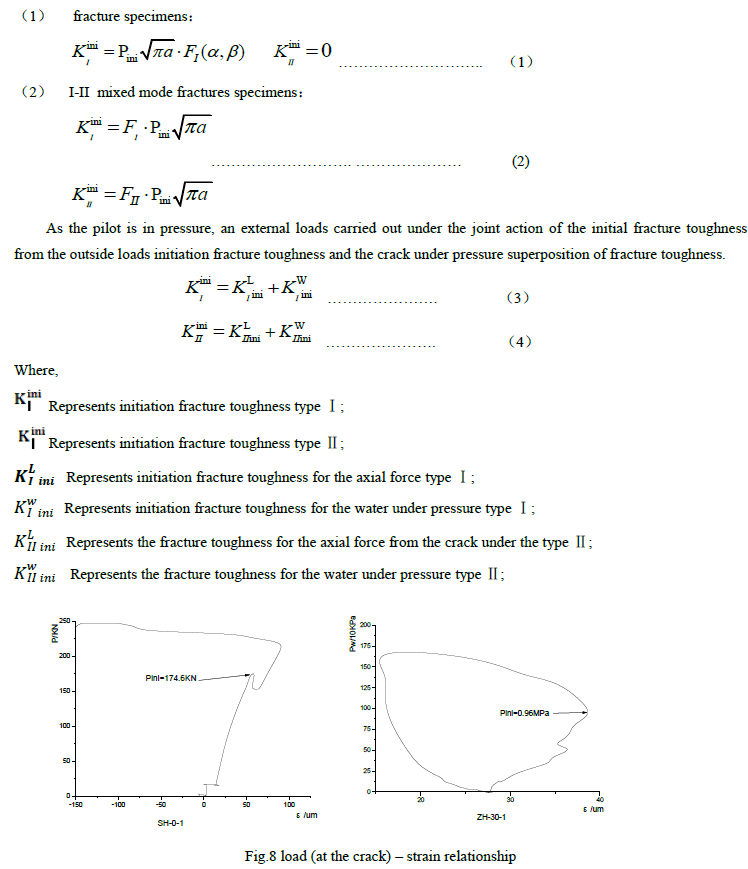 |
| B. Experimental determination of unstable fracture toughness |
| Fracture toughness is composed of two parts: the axial loads and loads of water instability under pressure, which is calculated from the total superimposed unstable fracture toughness and it is determined based on P-CMOD curve rising section, Fig. 4. Because crack instability has been completed in the expansion phase, the crack length becomes the initial crack length and the length of the crack propagation. Measurement of the extended length of the test method was as follows: initially, the strain continued to accumulate as the load increased linearly with increasing energy, after reaching the maximum strain, the strain began to retracted, the energy is released, which showed that, strain gage crack had been extended to the maximum strain value corresponding to the load, that is, the crack extension load value, for which we can monitor each of the strain gauge crack extension process until the fracture specimen is unstable. |
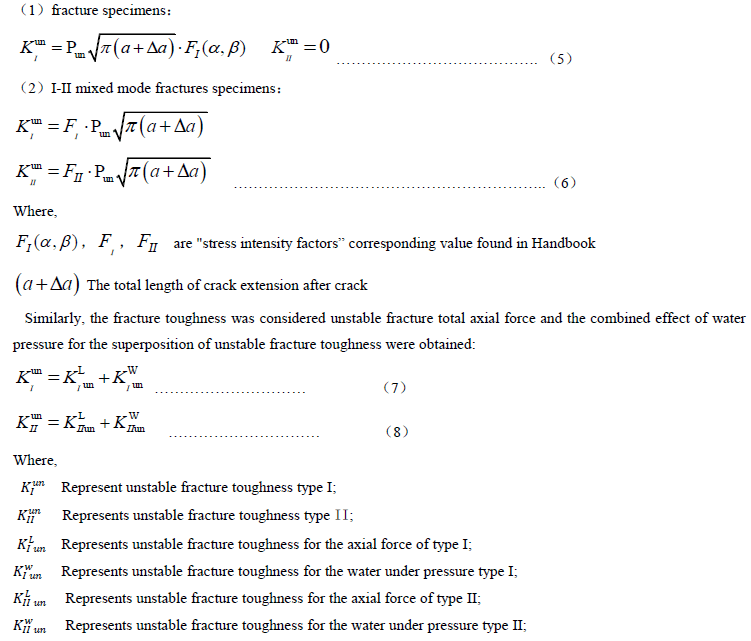 ' ' |
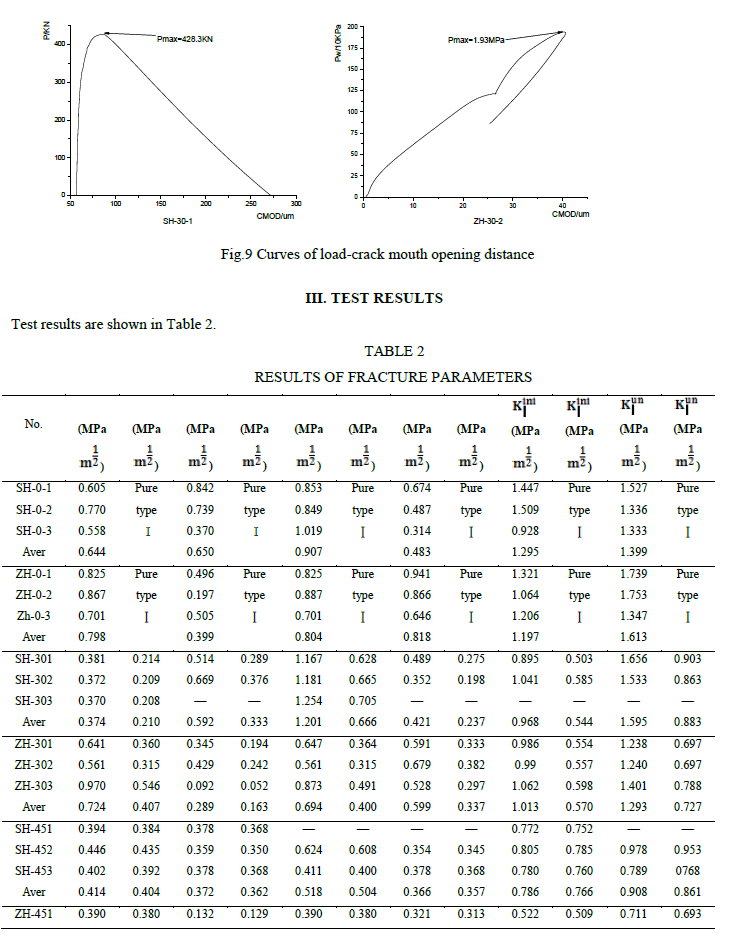 |
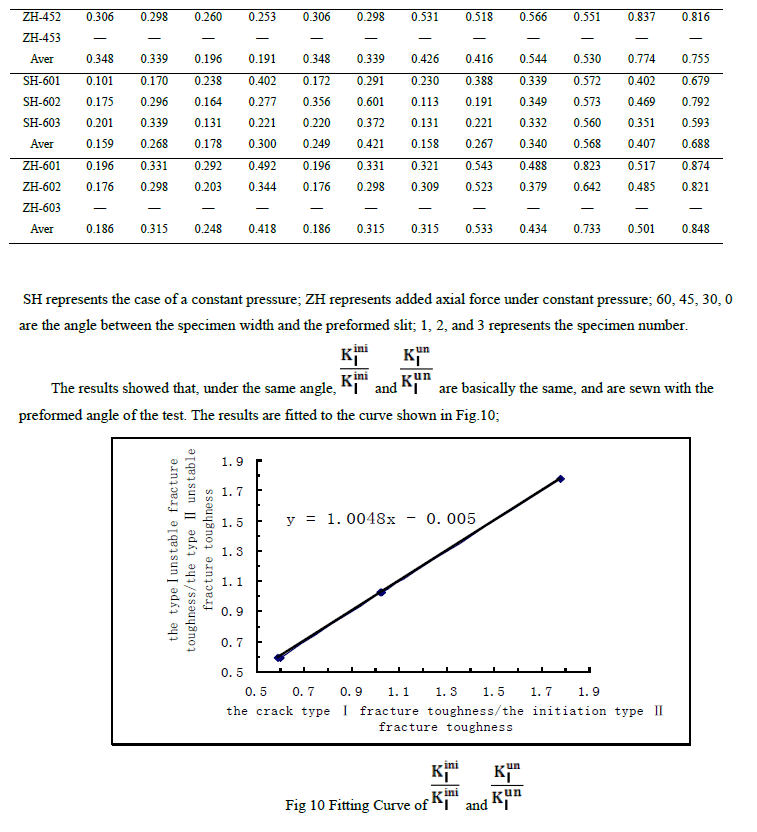 |
| The mathematical expression for the result in table 2 is summarize in table 3 and the fitting curve of I-II mixed mode fracture is plotted, as in fig. 11-12. |
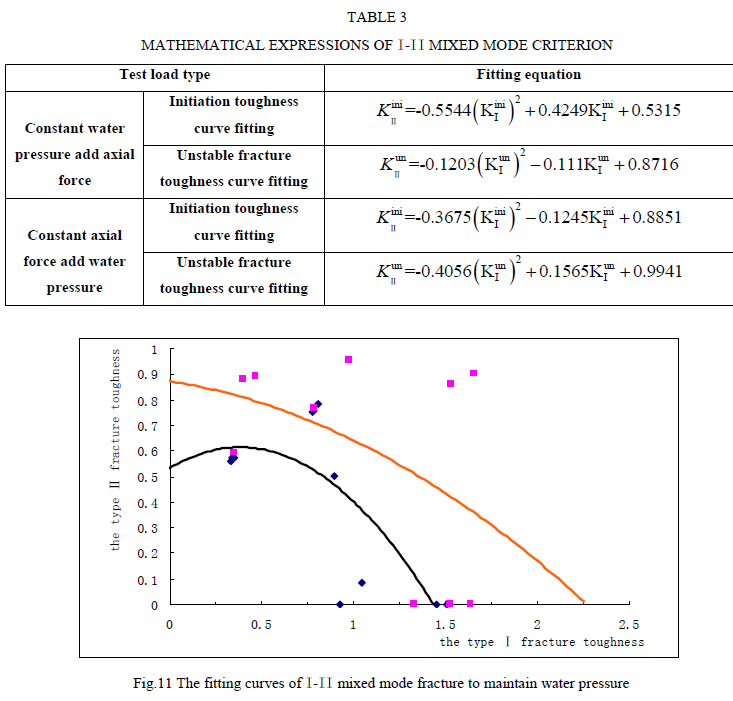 |
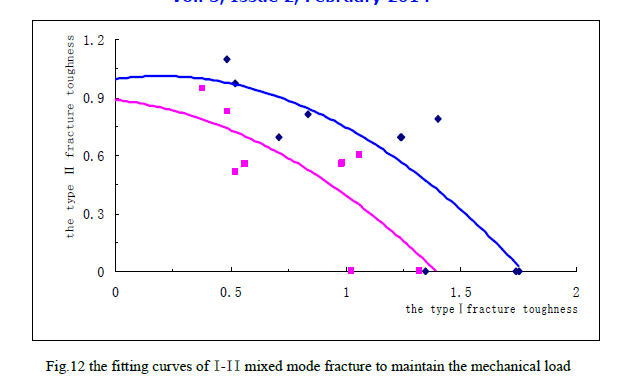 |
IV. CONCLUSION |
| The following conclusions could be drawn from the present investigation- |
| (1) It is observed that, the fracture toughness is calculated from the total demand superimposed fracture toughness by taking into account the axial load and water pressure. |
| (2) Double-K fracture criterion was applied in the calculation of crack initiation and unstable fracture toughness. Two different loading modes, that is, initiation and unstable fracture toughness are compared in both loading and stability lost of the fracture criterion. |
(3) I-II mixed mode fracture study used two loading modes type; I fracture components (initiation fracture toughness type I and unstable fracture toughness type I) are sewn with the prefabricated specimen with the width decreases with an increase in angle, II fracture components (initiation fracture toughness type II and unstable fracture toughness type II) are sewn with the prefabricated specimen, with the width increases. Under the same angle |
| are basically the same, and in both cases, width decreases with an increase of angle. |
References |
|